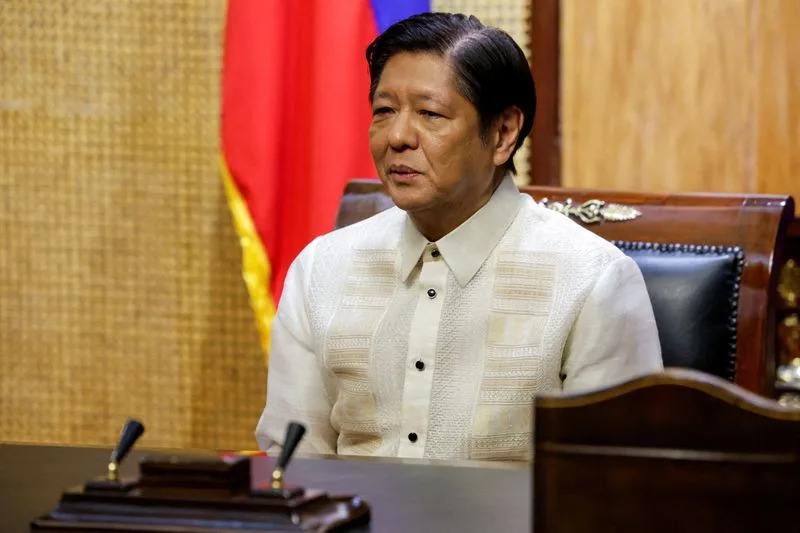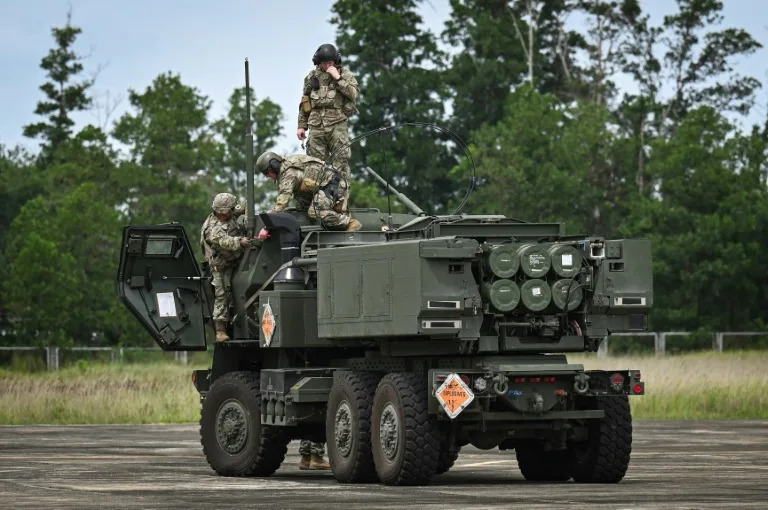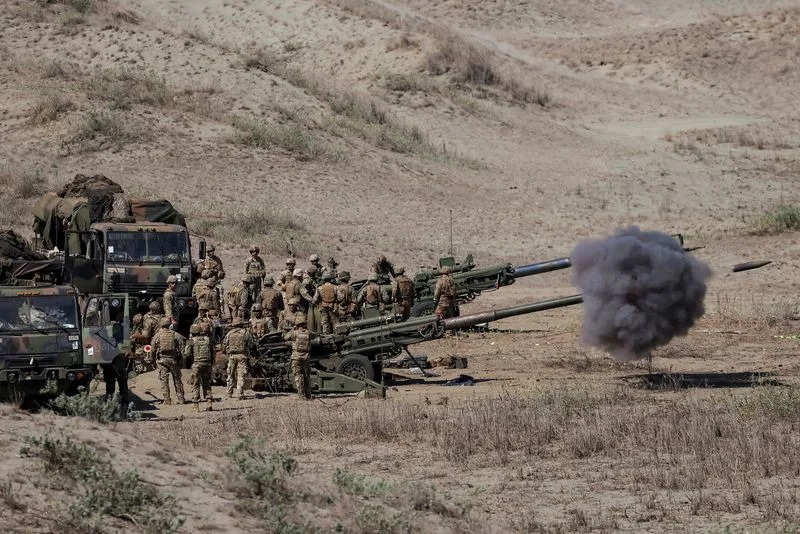U.S. Secretary of State Blinken visits the Philippines.
Philippines President Ferdinand Marcos Jr said on Monday the country will not use water cannons or any offensive weapons in the South China Sea.
The last thing the Philippines wants to do is to raise tensions in the strategic waterway, Marcos told reporters.
"We will not follow the Chinese coast guard and Chinese vessels down that road," Marcos said, adding that the mission of Philippine navy and coast guard was to lower tensions, and there no plans to install water cannons on vessels.
China's embassy in Manila did not immediately respond to a request for comment.
Last week, Manila protested Beijing's use of water cannons against Filipino vessels at a disputed shoal in the South China Sea, describing it as harassment and "dangerous manoeuvres", after a rise in tensions in recent months.
China claims sovereignty over much of the South China Sea, a conduit for more than $3 trillion of annual ship-borne commerce, including parts claimed by the Philippines, Vietnam, Indonesia, Malaysia and Brunei.
An international tribunal in 2016 said China's expansive claim had no legal basis, a decision Beijing has rejected.
Get AfriPrime Android Web View app....Click the link to Amazon app store to download https://rb.gy/3xek46
Philippines, US fire at 'invasion' force in South China Sea war games
Soldiers put up the antenna of a HIMARS rocket system as part of the Balikatan military exercises last week.
US and Filipino troops fired missiles and artillery at an imaginary "invasion" force during war games on the Philippines' northern coast Monday, days after their governments objected to China's "dangerous" actions in regional waters.
Thousands of troops are conducting land, sea and air manoeuvres against a backdrop of increased confrontations between Chinese and Filipino vessels around shoals in the South China Sea claimed by Manila, as well as stepped-up Chinese air and naval activity around nearby self-ruled Taiwan.
US troops massed at a strip of sand dunes on Luzon island's northwest coast -- around 400 kilometres (249 miles) south of Taiwan -- let loose more than 50 live 155mm howitzer rounds at floating targets about five kilometres off the coast, AFP journalists saw.
Filipino troops followed up by firing rockets aimed at wearing down the attackers, before the two forces finished the job with machine guns, Javelin missiles and more artillery rounds.
Lieutenant General Michael Cederholm, commander of the US First Marine Expeditionary Force, said the exercise was "to prepare for the worst" by "securing key maritime terrain".
"It's designed to repel an invasion," Cederholm told reporters at the exercise site.
"Our northwestern side is more exposed," Major General Marvin Licudine, exercise director for the Filipinos, told AFP ahead of the live firing at the La Paz sand dunes near Laoag city.
"Because of the regional problems that we have... we have to already practise and orient ourselves in our own land in these parts," he added.
Beijing claims almost the entire South China Sea despite an international ruling that its assertion has no legal basis.
Get AfriPrime Android Web View app....Click the link to Amazon app store to download https://rb.gy/3xek46
It deploys hundreds of coast guard, navy and other vessels to patrol and militarise the waters.
Just last week, Manila said the China Coast Guard damaged a Philippine Coast Guard ship and another government vessel in water cannon attacks around the disputed China-controlled Scarborough Shoal in the South China Sea on April 30.
More than 16,700 Filipino and American troops are taking part in the annual military drills -- dubbed Balikatan, or "shoulder to shoulder" in Tagalog -- in multiple locations across the Asian archipelago.
- 'Destabilising conduct' -
Maritime confrontations between China and the Philippines have raised fears of a wider conflict that could involve the United States and other allies.
Monday's exercise came days after the defence ministers of the Philippines, the United States, Japan and Australia met in Hawaii and issued a joint statement on their strong objections to the "dangerous and destabilising conduct" of China in the South China Sea.
The ministers "discussed opportunities to further advance defence cooperation" and to "work together to support states exercising their rights and freedoms in the South China Sea".
Last week, US forces taking part in the Balikatan exercises fired HIMARS precision rockets into the South China Sea from the western island of Palawan, the nearest major Philippine landmass to the hotly disputed Spratly Islands.
The US Marine Corps said the manoeuvre was a rehearsal for the rapid deployment of the missile system across the Philippines' South China Sea coast to "secure and protect Philippines' maritime terrain, territorial waters and exclusive economic zone interests".
Get AfriPrime Android Web View app....Click the link to Amazon app store to download https://rb.gy/3xek46
The confrontations between the Philippines and China comes as tensions have ratcheted up between Beijing and Taipei, which is about to inaugurate a new president regarded by China as a dangerous separatist.
Taiwan's defence ministry said Friday it had detected 26 Chinese aircraft and five naval vessels around the self-ruled island in the previous 24 hours.
"To a degree, military exercises are a form of deterrence," Philippine Foreign Secretary Enrique Manalo was quoted as saying in remarks delivered on his behalf by an aide at a public workshop on Friday.
"The more we simulate, the less we actuate," he added.
Philippines Denies ‘New Model’ in Dealing with China on Sea Row
Two senior Philippine officials on Sunday denied a claim by China that Manila had agreed on a “new model” in handling their territorial dispute in the South China Sea.
Philippine Defense Secretary Gilberto Teodoro Jr. and National Security Adviser Eduardo Ano issued separate statements, with Teodoro branding the claim “devious machination” and Ano calling it “absolutely absurd, ludicrous, and preposterous.”
A spokesperson by the Chinese Embassy in Manila on Saturday said the Philippine military’s Western Command, which oversees the South China Sea, early this year agreed on a new model to manage the situation in the Second Thomas Shoal. That’s where tensions between the two countries have escalated in recent months.
Read more: Why China, Philippines Keep Clashing at Sea and What Comes Next
Details of the new model have not been released, but the Chinese Embassy said the Western Command made “repeated confirmation” that it had been approved by “all key officials in the Philippine chain of command,” including the national defense secretary and the national security adviser.
Get AfriPrime Android Web View app....Click the link to Amazon app store to download https://rb.gy/3xek46
Teodoro said he had “disallowed any contact” between his department and the Chinese Embassy following his meeting with Ambassador Huang Xilian in July. Ano said neither he nor any concerned officials have “consented nor committed to any proposal that will compromise the national interest.”
The Chinese Embassy did not immediately respond to a request for comment on the remarks of the Philippine officials outside of usual business hours.
China’s statement on the new model came after President Ferdinand Marcos Jr.’s administration disowned a similar pact dubbed “gentleman’s agreement,” which China said was reached during former President Rodrigo Duterte’s tenure.
Philippines, US repel mock foreign invaders in annual military exercises
U.S. and Philippine armed forces fired missiles and artillery to thwart a simulated invasion in the Philippines' northern waters facing Taiwan on Monday, in a show of military force and strengthening ties as regional tensions rise.
About 200 soldiers took turns defending the shores of the coastal city of Laoag in Ilocos province, launching Javelin missiles and firing howitzers and machine guns to repel an unnamed enemy trying to storm the beach.
U.S. and Filipino military personnel sank five floating pontoons standing in for amphibious landing ships as part of their annual exercises called Balikatan, or "shoulder-to-shoulder".
The annual drills, which involve about 16,000 Filipino and American troops and began last month, will run until May 10. They come at a time of escalating tensions between the Philippines and China in the South China Sea.
Get AfriPrime Android Web View app....Click the link to Amazon app store to download https://rb.gy/3xek46
Last week, the Philippines accused China of using water cannons against their vessels around the disputed Scarborough Shoal, which damaged naval vessels and injured people onboard.
On Monday, Philippine President Ferdinand Marcos Jr said his country would not retaliate in kind, saying the Philippines did not want to raise tensions.
The exercises have irked China, which has warned of destabilisation when countries outside the region "flex muscles and stoke confrontation".
Several of the drills this year were set in islands and provinces facing Taiwan and the South China Sea. Laoag City is about 408 km (254 miles) from Taiwan's southernmost point.
'NOT FOR MESSAGING'
U.S. Marines Lieutenant General Michael Cederholm, commander of joint task force Balikatan, told reporters on Monday the exercises were meant to improve how the forces operate alongside each other and were not directed against a specific adversary.
"We don't do this for any third party. We don't do this for messaging. We do this to create interoperability," Cederholm said, without mentioning China.
The main exercises will culminate with a "maritime strike" on Wednesday, in which the combined forces of the Philippines and the United States will sink a decommissioned Philippine navy ship. The annual drills will officially end on Friday.
Other exercises have included simulations of retaking occupied islands and a multilateral sail with France and Australia in the South China Sea, inside the Philippines' exclusive economic zone.
Get AfriPrime Android Web View app....Click the link to Amazon app store to download https://rb.gy/3xek46
Security engagements between Manila and Washington have increased under Philippine President Ferdinand Marcos Jr., who has allowed Americans to access more Philippine bases under an enhanced defence cooperation agreement, including facilities close to Taiwan and facing the South China Sea.
The United States and Philippines also began joint patrols in the South China Sea last year.
U.S. officials, including President Joe Biden, have affirmed its "ironclad" commitment to defend the Philippines against any armed attack under their 1951 mutual defence treaty.





